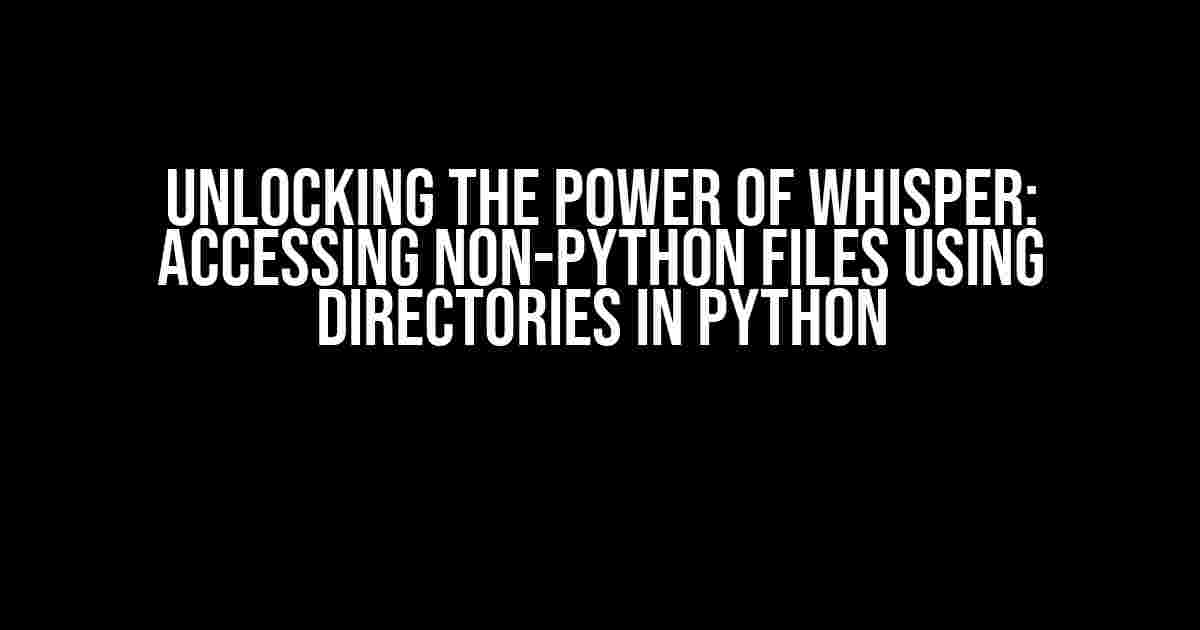Welcome to the world of speech-to-text magic! If you’re reading this, chances are you’re interested in harnessing the incredible capabilities of the Whisper library in Python. But, you’ve hit a roadblock – you need to access non-Python files using directories, and you’re not sure how. Fear not, dear reader, for we’re about to embark on a thrilling adventure to conquer this challenge together!
What is Whisper, and why do I need to access non-Python files?
Whisper is a remarkable open-source speech-to-text system that’s taken the world by storm. It’s capable of transcribing audio files with uncanny accuracy, making it an indispensable tool for a wide range of applications, from virtual assistants to language translation systems. However, to unleash its full potential, you need to provide Whisper with access to the necessary files, which might not always be in Python.
The Problem: Inaccessible Files
Imagine you have a treasure trove of audio files stored in a directory, just waiting to be transcribed. But, alas! These files are in various formats, such as WAV, MP3, or even video files like MP4. How do you tap into this rich resource using Python? The answer lies in understanding how to access and manipulate directories in Python.
Directories in Python: A Crash Course
Before diving into the world of Whisper, let’s take a brief detour to explore the basics of working with directories in Python. Don’t worry, it’s easier than you think!
The `os` Module: Your New Best Friend
The `os` module is a built-in Python package that provides a wealth of functions for interacting with the operating system and file system. It’s your go-to tool for navigating and manipulating directories. Let’s get familiar with some essential functions:
os.getcwd(): Returns the current working directory.os.chdir(path): Changes the current working directory to the specified path.os.listdir(path): Lists the files and directories in the specified path.os.path.join(path, *paths): Joins multiple paths together, ensuring the correct separator character.os.path.exists(path): Checks if a file or directory exists at the specified path.
import os
# Get the current working directory
print(os.getcwd())
# Change the current working directory
os.chdir('/path/to/new/directory')
# List the files and directories in the new directory
print(os.listdir())
# Join multiple paths together
new_path = os.path.join('/path/to', 'directory', 'file.txt')
print(new_path)
# Check if a file exists
if os.path.exists('/path/to/file.txt'):
print("File exists!")
else:
print("File not found!")
Accessing Non-Python Files using Directories in Python
Now that you’ve got a solid grasp of working with directories in Python, it’s time to focus on accessing non-Python files. We’ll explore three common scenarios:
Scenario 1: Accessing Audio Files in the Same Directory
Let’s say you have an audio file called `audio.wav` in the same directory as your Python script. To access it, you can use the following code:
import os
# Get the current working directory
cwd = os.getcwd()
# Construct the full path to the audio file
audio_file_path = os.path.join(cwd, 'audio.wav')
# Check if the file exists
if os.path.exists(audio_file_path):
print("Audio file found!")
else:
print("Audio file not found!")
Scenario 2: Accessing Files in a Subdirectory
What if your audio files are stored in a subdirectory? No problem! You can use the `os.path.join()` function to construct the full path:
import os
# Get the current working directory
cwd = os.getcwd()
# Construct the full path to the subdirectory
subdirectory_path = os.path.join(cwd, 'audio_files')
# Construct the full path to the audio file
audio_file_path = os.path.join(subdirectory_path, 'audio.wav')
# Check if the file exists
if os.path.exists(audio_file_path):
print("Audio file found!")
else:
print("Audio file not found!")
Scenario 3: Accessing Files in a Different Directory
Sometimes, you might need to access files in a completely different directory. You can use the `os.chdir()` function to change the current working directory:
import os
# Change the current working directory
os.chdir('/path/to/different/directory')
# Construct the full path to the audio file
audio_file_path = os.path.join(os.getcwd(), 'audio.wav')
# Check if the file exists
if os.path.exists(audio_file_path):
print("Audio file found!")
else:
print("Audio file not found!")
Putting it all Together: Accessing Non-Python Files for Whisper
Now that you’ve mastered the art of accessing non-Python files using directories in Python, it’s time to integrate this knowledge with the Whisper library. Here’s an example of how you can transcribe an audio file using Whisper:
import os
import whisper
# Change the current working directory
os.chdir('/path/to/audio/files')
# Construct the full path to the audio file
audio_file_path = os.path.join(os.getcwd(), 'audio.wav')
# Create a Whisper instance
whisper_instance = whisper.Whisper(lang='en', verbose=False)
# Load the audio file
audio_data = whisper_instance.load_audio(audio_file_path)
# Transcribe the audio file
transcription = whisper_instance.transcribe(audio_data)
print("Transcription:", transcription['text'])
Conclusion: Unleashing the Power of Whisper
Congratulations! You’ve successfully accessed non-Python files using directories in Python, paving the way for a seamless integration with the Whisper library. With this newfound knowledge, you’re ready to unlock the full potential of Whisper and take your speech-to-text projects to the next level.
Remember, the key to success lies in understanding how to navigate and manipulate directories in Python. By mastering this skill, you’ll be able to tap into a vast array of file formats and unlock the secrets of speech-to-text magic.
| Directory Function | Description |
|---|---|
os.getcwd() |
Returns the current working directory. |
os.chdir(path) |
Changes the current working directory to the specified path. |
os.listdir(path) |
|
os.path.join(path, *paths) |
Joins multiple paths together, ensuring the correct separator character. |
os.path.exists(path) |
Checks if a file or directory exists at the specified path. |
Happy coding, and remember to always keep exploring the wonders of Python and Whisper!
Frequently Asked Questions
Need help accessing non-Python files using directories in Python for the Whisper library? We’ve got you covered!
How do I import non-Python files using directories in Python for Whisper?
To import non-Python files, such as audio files, you can use the `os` module to navigate through directories and access the files. For example, if you have an audio file named `audio.wav` in a directory called `audio_files`, you can use `os.path.join(‘audio_files’, ‘audio.wav’)` to access the file.
Can I use relative paths to access non-Python files in Python?
Yes, you can use relative paths to access non-Python files in Python. For example, if your Python script is in the same directory as the non-Python file, you can use a relative path like `./audio_files/audio.wav` to access the file. However, be careful when using relative paths, as they can be affected by the current working directory of your Python script.
How do I access non-Python files in a sibling directory using Python?
To access non-Python files in a sibling directory, you can use the `os` module to navigate up one level and then into the sibling directory. For example, if your Python script is in a directory called `scripts` and you want to access a file in a sibling directory called `audio_files`, you can use `os.path.join(os.path.dirname(__file__), ‘..’, ‘audio_files’, ‘audio.wav’)` to access the file.
Can I use the `pathlib` module to access non-Python files in Python?
Yes, you can use the `pathlib` module to access non-Python files in Python. The `pathlib` module provides a more modern and Pythonic way of working with paths and files. For example, you can use `pathlib.Path(‘audio_files’).glob(‘*.wav’)` to access all WAV files in the `audio_files` directory.
Are there any best practices for accessing non-Python files in Python for Whisper?
Yes, it’s a good practice to use absolute paths instead of relative paths to avoid any confusion or errors. You should also ensure that the file path is correctly formatted and that the file exists before trying to access it. Additionally, consider using try-except blocks to handle any errors that may occur when accessing files.




![The Agonizing Truth About os.rename(): Conquering the PyErr “OSError: [WinError 123]” The Agonizing Truth About os.rename(): Conquering the PyErr “OSError: [WinError 123]”](https://clarey.hkhazo.biz.id/wp-content/uploads/sites/828/2024/07/the-agonizing-truth-about-os-rename-conquering-the-pyerr-oserror-winerror-123-with-text-300x300.jpg)

